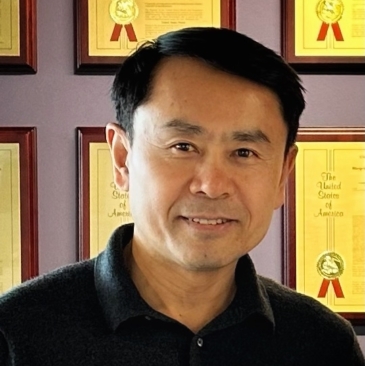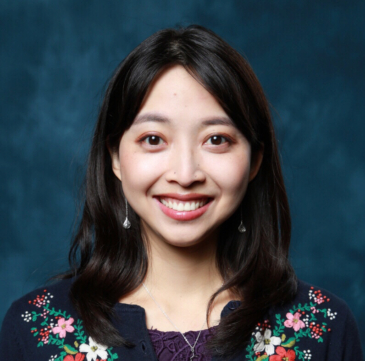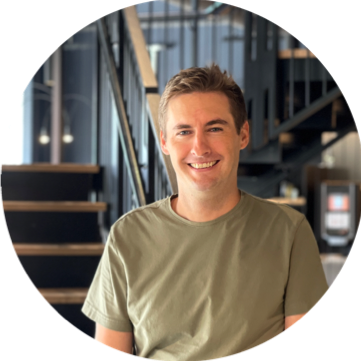We are a global biopharmaceutical company that invents life-changing medicines for people with serious diseases.

Our company was founded on the idea that the research and development of innovative medicines could be accelerated. Within a decade, we discovered and secured global approvals for two breakthrough medicines and assembled a promising pipeline of investigational therapies.
Today, we are bolder and more ambitious than ever before in our effort to improve and extend the lives of many more patients with serious diseases.
A look inside our labs
Our scientists merge expertise in bioinformatics, structural and cell biology, and world-class drug design capabilities to advance our discovery portfolio. Our approach enables us to rapidly identify compelling disease targets and design innovative therapies that treat root causes of disease.
The result is a robust and diverse portfolio of clinical- and research-stage programs in allergy/inflammation and oncology/hematology. With a steadfast commitment to scientific excellence and to patients, we aim to rapidly and unequivocally change the face of medicine.
Meet our Scientists

Guang Yang: Senior Principal Scientist, Translational Medicine
My path
I received my Ph.D. training in Immuno-Oncology at the Cancer Institute & Hospital, Chinese Academy of Medical Sciences (CAMS) & Peking Union Medical College (PUMC). After graduation, I joined the Dana-Farber Cancer Institute for my postdoctoral training in Hematology Oncology. Then, I earned an appointment as an Instructor in Medicine at Dana-Farber Cancer Institute & Harvard Medical School, and subsequently became a Senior Scientist at Bing Center for Waldenström Macroglobulinemia (WM).
My experience
During my years at Dana-Farber, I was involved in the development of a treatment for WM. We first identified the MYD88 L265P mutation in 95% of WM patients and then Bruton’s tyrosine kinase (BTK) as a downstream target. The translational study and drug development experience around BTK and other kinases in B-cell lymphoma inspired me to join Blueprint Medicines, a leading company in developing kinase-targeting drugs for mast cell-related diseases.
My biggest achievement
I was fortunate enough to be involved in the discovery of the MYD88 L265P mutation in WM and its downstream targets, which led to a successful clinical trial in WM. The reverse-translational studies I led to identify the mechanisms of resistance and further drug development efforts to overcome this resistance represented a typical model of “bench-to-bedside and bedside-to-bench” for increasing WM patients’ survival and improving their quality of life.
My recent scientific publications
“A new role for the SRC family kinase HCK as a driver of SYK activation in MYD88 mutated lymphomas,” published in Blood Advances in 2022
“The HCK/BTK inhibitor KIN-8194 is active in MYD88-driven lymphomas and overcomes mutated BTKCys481 ibrutinib resistance,” published in Blood in 2021
“Phase 1 study of ibrutinib and the CXCR4 antagonist ulocuplumab in CXCR4-mutated Waldenström macroglobulinemia,” published in Blood in 2021
“SYK is activated by mutated MYD88 and drives pro-survival signaling in MYD88 driven B-cell,” published in Blood Cancer Journal in 2020
“Expression of the prosurvival kinase HCK requires PAX5 and mutated MYD88 signaling in MYD88-driven B-cell lymphomas,” published in Blood Advances in 2020
“Genomic Landscape of Waldenström Macroglobulinemia and Its Impact on Treatment Strategies,” published in the Journal of Clinical Oncology in 2020
“Bruton tyrosine kinase degradation as a therapeutic strategy for cancer,” published in Blood in 2019
“BTKCys481Ser drives ibrutinib resistance via ERK1/2, and protects BTKWild-Type MYD88 mutated cells by a paracrine mechanism,” published in Blood in 2018 (Issue highlights with commentary)
“HCK is a survival determinant transactivated by mutated MYD88 and a direct target of ibrutinib,” published in Blood in 2016
“Ibrutinib in previously treated Waldenström’s macroglobulinemia,” published in the New England Journal of Medicine in 2015
“A mutation in MYD88 (L265P) supports the survival of lymphoplasmacytic cells by activation of Bruton’s Tyrosine Kinase in Waldenstrom’s Macroglobulinemia,” published in Blood in 2013
“MYD88 L265P somatic mutation in Waldenström’s macroglobulinemia,” published in the New England Journal of Medicine in 2012
My Blueprint Medicines
Joining Blueprint Medicines allowed me to get involved in drug development directly and have the opportunity to use reverse translational strategies in directing future drug development to benefit patients.

Stella (Yunxing) Li: Senior Scientist I, Biophysics
My path
I obtained my B.S. in Physics from Peking University and my Ph.D. in Biophysics from Cornell University (Richard A. Cerione’s lab). My graduate research was focused on using small molecule chemistry to block bioenergetic and metabolic requirements of cancer cell proliferation utilizing structural biology and biophysics approaches.
My experience
After I graduated from Cornell, I moved to Boston to join a computational drug discovery startup company. It was a tremendous learning experience, and I was able to utilize my structural biology skills to contribute to projects that made it to clinical programs. It was here that I was able to develop strong expertise in developing Surface Plasmon Resonance (SPR) assays to study a variety of targets. When I saw that Blueprint Medicines was looking to build out its Biophysics team with its first hire, I knew it was the perfect opportunity for me to grow and learn with such talented and passionate team.
My biggest achievement
During my time at the startup company, I was able to achieve the first co-crystal structure of the candidate compound while bound to its target. This enabled the R&D programs to move forward and shortly afterwards, the compound progressed to clinical trials. It was extremely exciting and rewarding to be a key contributor on a project that may one day be used in patients.
My recent scientific publications
“Predicting the structural basis of targeted protein degradation by integrating molecular dynamics simulations with structural mass spectrometry,” published in Nature Communications in 2022
“Adeno-associated viral vector-mediated immune responses: Understanding barriers to gene delivery,” published in Pharmacology & Therapeutics in 2020
“The activation loop and substrate-binding cleft of glutaminase C are allosterically coupled,” published in the Journal of Biological Chemistry in 2019
“Mechanistic Basis of Glutaminase Activation: A Key Enzyme that Promotes Glutamine Metabolism in Cancer Cells,” published in the Journal of Biological Chemistry in 2016
“Mechanism by which a recently discovered allosteric inhibitor blocks glutamine metabolism in transformed cells,” published in Proceedings of the National Academy of Sciences in 2014
“Small angle X-ray scattering studies of mitochondrial glutaminase C reveals extended flexible regions, and links oligomeric state with enzyme activity,” published in PLoS One in 2013
My Blueprint Medicines
I joined Blueprint because of the talented team, the amazing culture and the opportunity to make a true impact for our patients.

Tyler Rouskin-Faust: Senior Scientist II, Biology
My path
I received my B.S. in Biology from the University of Missouri in 2009. For my graduate work, I studied in the lab of Dr. Alan Frankel at UCSF, obtaining a Ph.D. in 2016. Finally, I was a post-doctoral fellow in the lab of Dr. Eric Fischer at Dana-Farber Cancer Institute until 2020.
My experience
My doctoral and post-doctoral studies were focused on aspects of protein degradation. I learned that Blueprint was entering into targeted protein degradation, and I was excited about the opportunity of joining and helping build a nascent effort at a company with a strong track record of bringing medicines to patients.
My biggest achievement
Coming into my postdoc, I had no structural biology experience but wanted to have a better understanding of the discipline. Over my three and a half years of training at Dana-Farber, several colleagues and I were able to solve the structure of an important protein-small molecule complex, which demonstrated that molecular glue degraders (MGD) were more common than the research community anticipated. On a personal level, this achievement also reinforced the idea that with focused effort and learning, daunting new challenges can always be overcome.
My recent scientific publications
“Structural complementarity facilitates E7820-mediated degradation of RBM39 by DCAF15,” published in Nature Chemical Biology in 2020
“Bruton tyrosine kinase degradation as a therapeutic strategy for cancer,” published in Blood in 2019
“The HIV-1 Tat protein recruits a ubiquitin ligase to reorganize the 7SK snRNP for transcriptional activation,” published in Elife in 2018
“Making Sense of Multifunctional Proteins: Human Immunodeficiency Virus Type 1 Accessory and Regulatory Proteins and Connections to Transcription,” published in the Annual Review of Virology in 2017
“PJA2 ubiquitinates the HIV-1 Tat protein with atypical chain linkages to activate viral transcription,” published in Scientific Reports in 2017
My Blueprint Medicines
I joined Blueprint because of the intense commitment to and record of success in bringing targeted medicines to patients in need.

Ludivine Moine: Senior Scientist II, Medicinal Chemistry
My path
I earned a chemical engineering degree from CPE Lyon, France and a M.Sc. in organic chemistry at the University of Montreal, Canada.
My experience
I worked in a big pharma in oncology for many years using different modalities, but I never worked with kinases. I wanted to work for a precision medicine company that specialized in this area and is fully dedicated to discovery. Blueprint Medicines naturally fit the bill.
I was also attracted to Blueprint by the company’s values and its focus on quickly delivering life-changing therapies, and I saw an amazing opportunity for growth and no glass ceiling.
My biggest achievement
I recently contributed to the design and synthesis of multiple research candidates during the COVID-19 pandemic. These efforts offer an opportunity to potentially benefit more patients who harbor specific mutations by targeting the underlying genetic drivers of their disease.
My recent scientific publications
“Identification and characterization of second-generation EZH2 inhibitors with extended residence times and improved biological activity,” published in the Journal of Biological Chemistry in 2021
“Design, Synthesis, and Pharmacological Evaluation of Second Generation EZH2 Inhibitors with Long Residence Time,” published in ACS Medicinal Chemistry Letters in 2020
“Molecular Basis of Valine-Citrulline-PABC Linker Instability in Site-Specific ADCs and Its Mitigation by Linker Design,” published in Molecular Cancer Therapeutics in 2016
“Site-Dependent Degradation of a Non-Cleavable Auristatin-Based Linker-Payload in Rodent Plasma and Its Effect on ADC Efficacy,” published in PLoS One in 2015
“Effect of attachment site on stability of cleavable antibody drug conjugates,” published in Bioconjugate Chemistry in 2015
“Discovery of a novel Kv7 channel opener as a treatment for epilepsy,” published in Bioorganic & Medicinal Chemistry Letters in 2015
My Blueprint Medicines
Blueprint is a pioneer in precision medicine, and I wanted to learn from the inside how the company has been able to provide innovative therapies to patients in record time. Our core values also resonate with me, and I specifically enjoy how deeply Blueprint invests in discovery and selects targets that may make the most and fastest impact on patients’ lives. Lastly, the collaborative, dynamic, diverse and empowering environment has been another big factor. I believe I can accomplish anything here, and I get the full support of my team to be the best version of myself.

Percy Carter, MBA, Ph.D., Chief Science OfficerWhen we think about research innovation at scale at Blueprint, it begins with our talent. Our team combines a deep expertise in the basic science that underpins modern drug discovery, with extensive experience in the applied and translational sciences behind science-led nonclinical development. This enables us to take advantage of our integrated research platform and create transformative new medicines for patients.
Scientific Advisory Board
Our Scientific Advisory Board provides their renowned expertise to provide guidance on our scientific approach and help shape our portfolio of innovative medicines.
George Demetri, M.D. (Chair)
Professor of Medicine, Harvard Medical School
Brian Druker, M.D.*
Chief Executive Officer, Oregon Health & Science University Knight Cancer Institute, and JELD-WEN Chair of Leukemia Research
Mark Goldberg, M.D.
Lecturer in Medicine, Harvard Medical School and Faculty Member, Hematology Division, Brigham and Women’s Hospital
Scott Lowe, Ph.D.*
Investigator, Howard Hughes Medical Institute and Chair, Cancer Biology and Genetics Program, Sloan Kettering Institute, Memorial Sloan Kettering Cancer Center
Nicholas Lydon, Ph.D.*
Scientific Founder, Blueprint Medicines
Charles L. Sawyers, M.D.*
Director, Human Oncology and Pathogenesis Program at Memorial Sloan-Kettering Cancer Center and Investigator, Howard Hughes Medical Institute
*Scientific Founder of Blueprint Medicines

